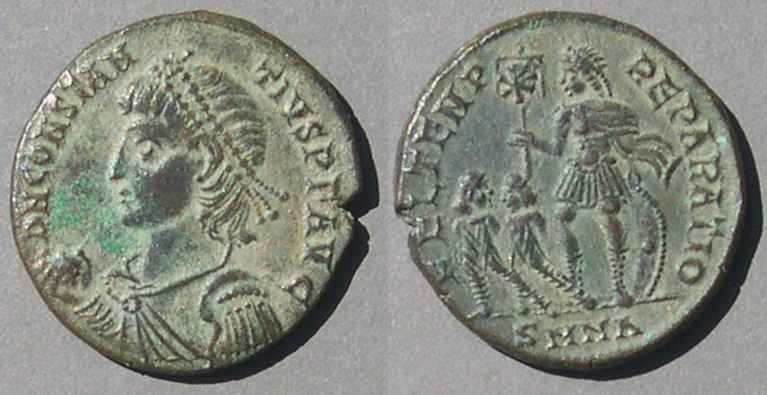 Coins of the Roman Emperor Constantius II
Coins of the Roman Emperor Constantius II(Caesar 324-337 and Augustus 337-361)
All his types of bronze coins.
(Skip down to the images of each type.)
 Coins of the Roman Emperor Constantius II
Coins of the Roman Emperor Constantius II
(Caesar 324-337 and Augustus 337-361)
All his types of bronze coins.
(Skip down to the images of each type.)
This site has 4 pages:
1) This page which lists all the types in tables with their images further down this page.
(There are similar pages for coins of Constans and Constantine II.)
(Image to the right: Constantius II, type F411.)
2) A page with additional images of FEL TEMP REPARATIO coins.
3) A page with additional images of types of Vetranio
4) A page with additional images of other types.
What's in the tables? The tables below lists a type set for Constantius II. It list all 39 of his bronze reverse types, but not varieties. Images are below. The same basic reverse design and legend from different mints is regarded as one type. My use of the terms type and variety is discussed below. The primary references are RIC VII and RIC VIII, but many types are issued from many mints and several obverses and would not have a unique RIC ID number, so I have chosen to use Failmezger numbers because his ID numbers are for reverse types. What this page contributes is the extraction of the types of one emperor--Constantius II.
What's new? 2025, August 24: VOT XV MVLT XX, F401. Larger images linked to the given images; click the images for enlargments.
Types of Constantius II fall into five broad categories:
1) Types as Caesar (324-337) Table 1.
2) Types as Augustus before the coin-reform of 348 (337-348) Table 2.
3) FEL TEMPREPARATIO types of the reform of 348. Table 3.
4) Types issued by Vetranio (March 1, 350 to Dec 25, 350) in the name of Constantius II. Table 4.
5) other post-reform types (348-361) Table 5.
Note for collectors: You are welcome to copy these tables to use them as a checklist.
| Failmezger #(image link) AE size |
Type (images below) | Rarity |
| F338, AE3 | CONSTANTIVS CAESAR horizontally, anepigraphic obverse | S |
| F342, AE3 | VOT V in wreath, CAESARVM NOSTRORVM (Only Thessalonica) | S |
| F354-5, AE3 | PROVIDENTIAE CAESS, campgate | C |
| F361-2 AE3 | VIRTVS CAESS, campgate | S |
| F365, AE4 | GLORIA EXERCITVS two soldiers and two standards | C |
| F372, AE4 | GLORIA EXERCITVS, two soldiers and one standard (This type is also used as Augustus, F381) |
C |
| F371, AE4 | CONSTANTIVS CAES, Roma standing left holds transverse spear and Victory (RIC VII Rome 410, "r5") | RRR |
| F375, AE4 | SECVRITAS REIPVB, Securitas leans on column (This type is also used as Augustus, F386) |
R |
|
Failmezger #(image link) |
Type (images below) | Rarity |
| F381, AE4 | GLORIA EXERCITVS two soldier and one standard (had also been used as Caesar, F372) |
C |
| F386, AE4 | SECVRITAS REIP, Securitas leans on column (had also been used as Caesar, F375) |
S |
| F388, AE4 | VIRTVS AVGG NN, emperor with spear and shield. Only Trier | R |
| F389, AE4 | VIRTVS AVGVSTI, emperor with spear and shield. Only Rome | RR |
| F392, 394 AE4 | VICT AVG[G], Victory with wreath and palm. Only Alexandria and Antioch | S |
| F394, AE4 | VICTORIA AVGG, Victory with wreath and palm, sometimes with chi-rho in left field | S |
| F396, AE4 | VICTORIA AVGG, Victory with two wreaths, sometimes with chi-rho in right field. | S |
| F unlisted, AE4 | VICTORIA AVGVSTORV, Victory standing left with wreath and palm (RIC VIII Lugdunum 36 "R") | RR |
| F398, AE4 | VICTORIAE DD AVGG Q NN, two Victories facing each other | C |
| F401, AE4 | VOT XV MVLT XX in wreath. Only Antioch | R |
| F402, AE4 | VOT XX MVLT XXX in wreath | C |
| Failmzger #(image link) AE size |
Type (images) | Rarity |
| F409, 461-4 AE2-3 |
FEL TEMP REPARATIO, soldier spearing fallen horseman (comes in various sizes 24-17 mm) |
C |
| F408, F426 AE2 |
FEL TEMP REPARATIO, emperor on galley, holds phoenix or Victory, Victory at rudder (This is an AE2. The AE3 is next) | C |
| F414, AE3 | FEL TEMP REPARATIO, emperor on galley, holds phoenix or Victory (AE3, similar to but smaller than the previous type--thought to be a half denomination) | C |
| F410, AE2 | FEL TEMP REPARATIO, emperor leads barbarian from hut underneath a tree (different varieties for each mint) |
C |
| F411, AE2 | FEL TEMP REPARATIO, emperor with two captives to left | C |
| F412, AE2 | FEL TEMP REPARATIO, horseman rides down two foes | RR |
| F425, AE2 | FEL TEMP REPARATIO, emperor and one captive to left. Only Thessalonica. | R |
| F413, F451 AE3 |
FEL TEMP REPARATIO, phoenix on pyre (looks like a pile of rocks) | C |
| F413, AE3 | FEL TEMP REPARATIO, phoenix on globe | S |
| F465, AE3 | FEL TEMP REPARATIO, large M in center. Only Rome. (RIC VIII Rome 313, "R3") | RRR |
| Failmezger #(image link) AE size |
Type (images) | Rarity |
| F415, AE2 | CONCORDIA MILITVM, emperor with two standards with chi-rhos | S |
| F416, AE2 | HOC SIGNO VICTOR ERIS, Emperor standing holding standard with chi-rho, to r. is Victory, crowning him with wreath and holding palm branch | S |
| F418, AE3 | GLORIA ROMANORVM, Emperor standing front, holding standard with chi-rho and reversed spear. | R |
| F419, AE3 | VIRTVS AVGVSTORVM, Emperor standing right holding spear and globe, kicking captive. | R |
| Failmezger #(image link) AE size |
Type (images) | Rarity |
| F429, AE2 | GLORIA ROMANORVM, horseman spears foe | S |
| F431, AE2 | GLORIA ROMANORVM, emperor raises city of Aquileia. Only Aquileia. (RIC VIII Aquileia 186, "R4") | RRR |
| F433, AE2 | SALVS AVG NOSTRI, large chi-rho. Only Trier. | S |
| F466, AE3 | SPES REIPVBLICAE, emperor stands with globe and reversed spear | C |
| F442, AE2 | VICT DD NN AVG ET CAES, two Victories hold shield inscribed VOT XXX, chi-rho above. (RIC VIII Rome 251-2 "R2") | RR |
| F455, AE4 | VICTORIA AVGVSTORM, Victory adv left holding up wreath in each hand. Only Siscia and Sirmium. | RR |
| F456, AE4 | VICTORIA CAESARIS, Victory adv left with wreath and palm. Only at Siscia. |
RR |
Constantius II, as Caesar, 324-337. From Table 1.
F338: CONSTAN/TIVS/CAESAR, Anepigraphic obverse.
Anepigraphic.
CONSTAN/TIVS/CAESAR/
SMANTS
This example: 18 mm. RIC VII Antioch 60.
Note for collectors: Anepigrapic coins like this were issued for Constantine, Crispus, Constantine II, Constantius II, Helena, and Fausta. For Constantius II they are common from Antioch and rare from the other mints.


F372: GLORIA EXERCITVS, with one soldier and one standard (as Caesar)
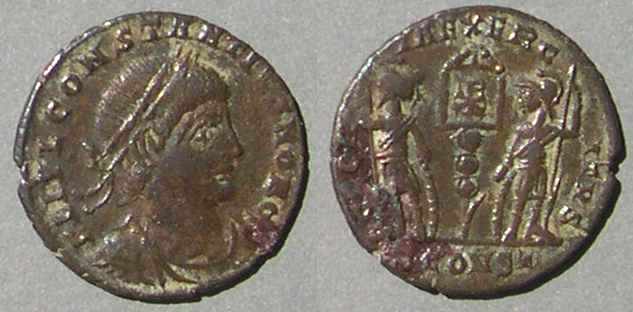 Constantius II, as Caesar
Constantius II, as Caesar
GLORIA EXERCITVS
two soldiers and one standard.
This example: 16 mm. RIC VII Arles 383 or 396.
Note for collectors: This is a very common type from many mints. It was also commonly imitated in ancient times, especially in Britain. This reverse for Constantius II as Caesar was continued for Constantius II as Augustus.
This type has an important variety with a chi-rho on the standard (this coin) which is issued during Constantine's lifetime. We know because Constantius II is Caesar and not yet Augustus. Only from Arles = Constantina (at the time Arelate was renamed Constantina for Constantine II. The "CONS" in the mintmark can be confused with Constantinople). There are similar coins with a chi-rho on the standard from Sisica (F381), but they are with Constantius II as Augustus and therefore not during the lifetime of Constantine.
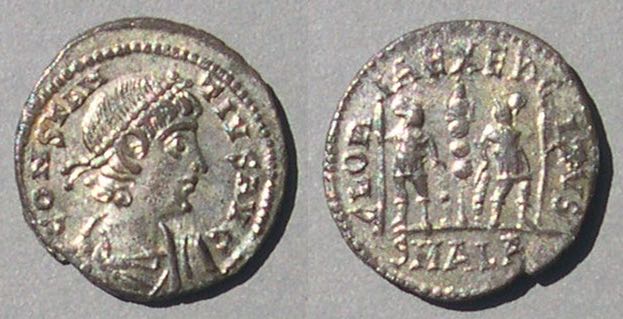
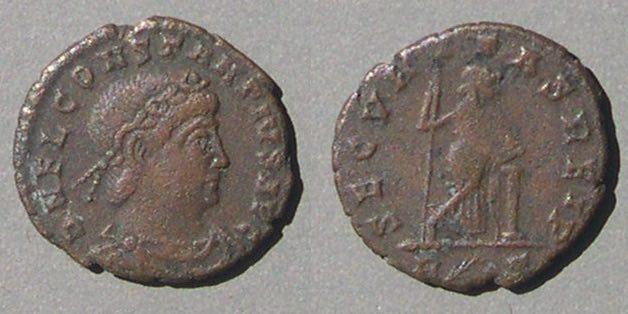

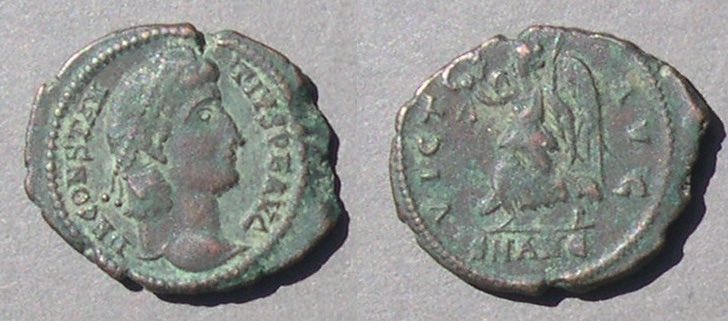
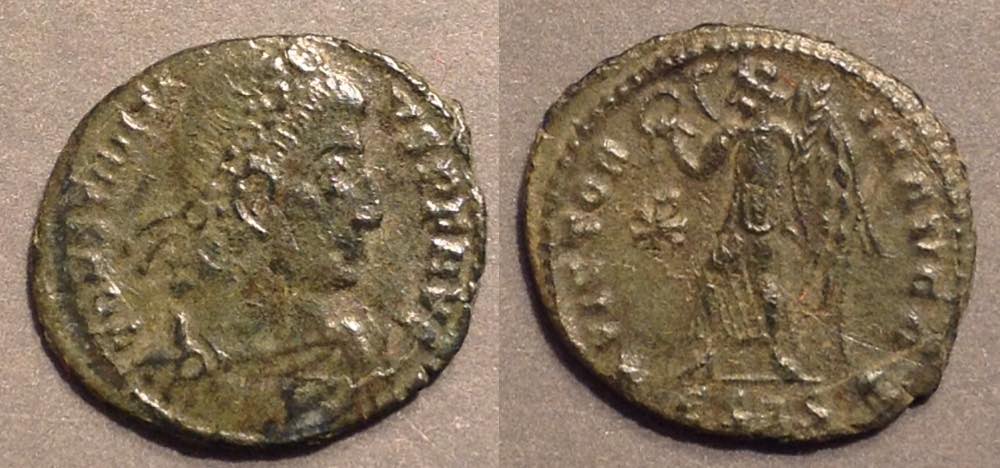 VICTORIA AVGG
VICTORIA AVGG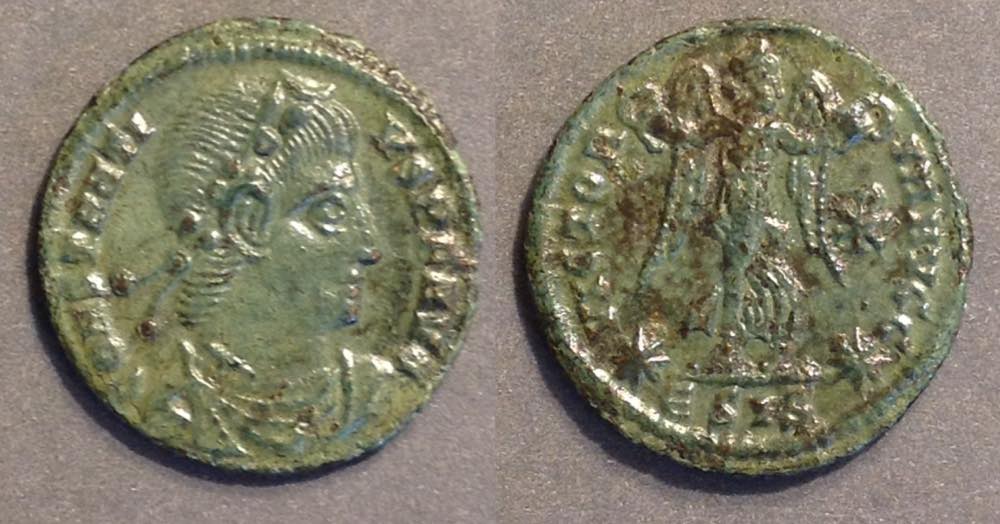
 VICTORIA AVGVSTORV
VICTORIA AVGVSTORV
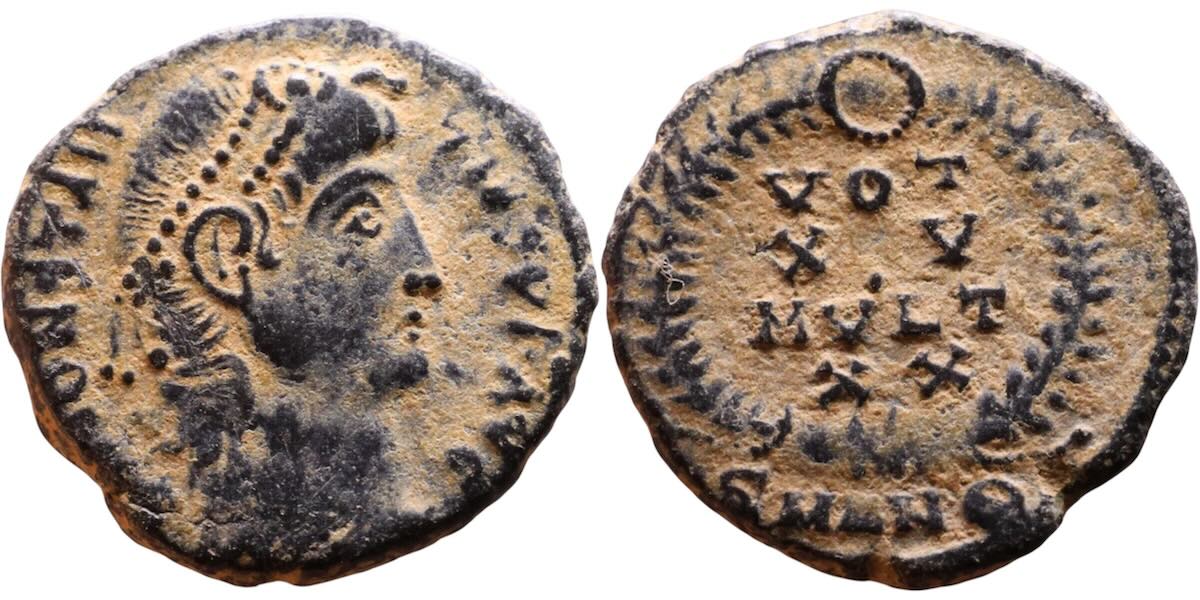 This example: 14 mm. 1.63 grams.
This example: 14 mm. 1.63 grams.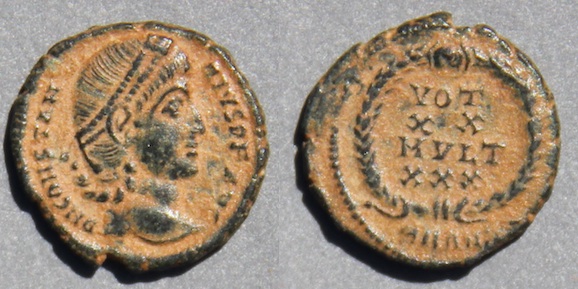
F409: FEL TEMP REPARATIO, soldier spearing fallen horseman
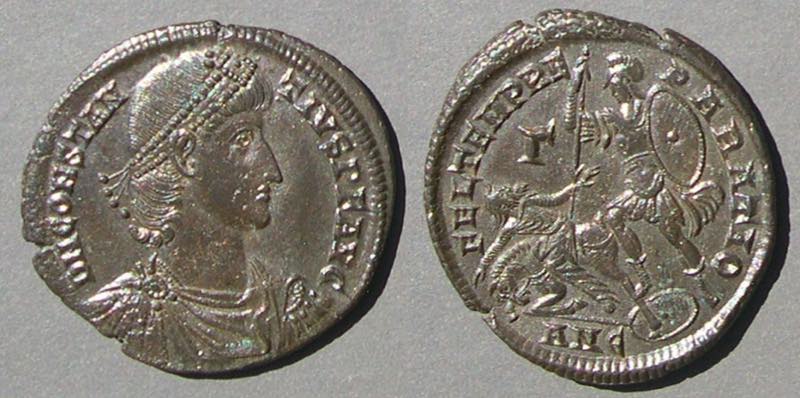 FEL TEMP REPARATIO
FEL TEMP REPARATIO
soldier spearing fallen horseman
This type comes in various sizes 24-17 mm.
(See the next photo for relative sizes)
This example: 25-23 mm. RIC VIII Antioch 132.
Note for collectors: This type is very common. It is widely collected by mint and by position of the "fallen horseman" (which can be "reaches back," like this example, or "kneels" or "sits [next to the horse] " or "clutches [the horse]"
Its size declined rapidly over time (see the next image).
Some varieties have special interest, such as those with LXXII in the field (coin), for "72" coins to the pound.
Because they are common and inexpensive in nice shape from many mints in many varieties, they make an interesting series to collect.
(Other examples)
F408: FEL TEMP REPARATIO, emperor on galley, AE2
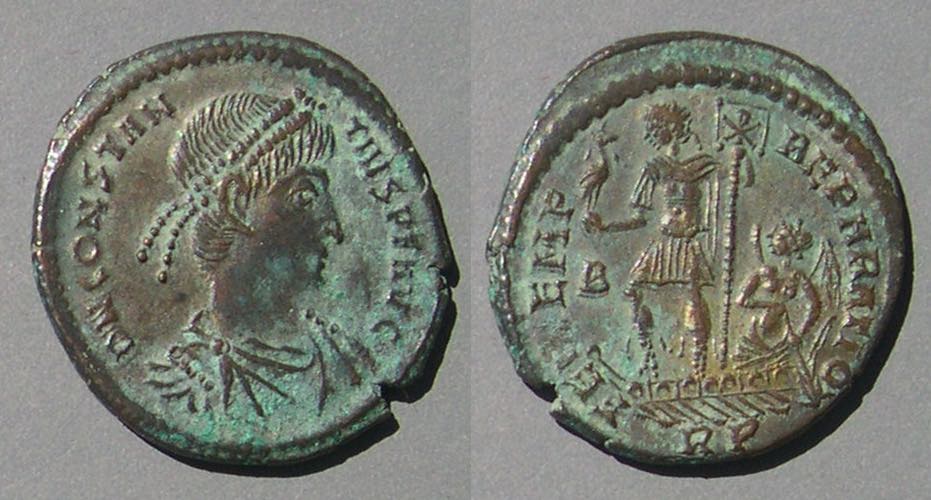
FEL TEMP REPARATIO,
emperor on galley, holds phoenix or Victory
(The design also comes as an AE3, next)
This example: 25 mm. RIC VIII Rome 115.
Note for collectors: This type is common. This example has the emperor holding a phoenix, while some have the emperor holding Victory crowning him.
(Other examples)
F414: FEL TEMP REPARATIO, emperor on galley, AE3
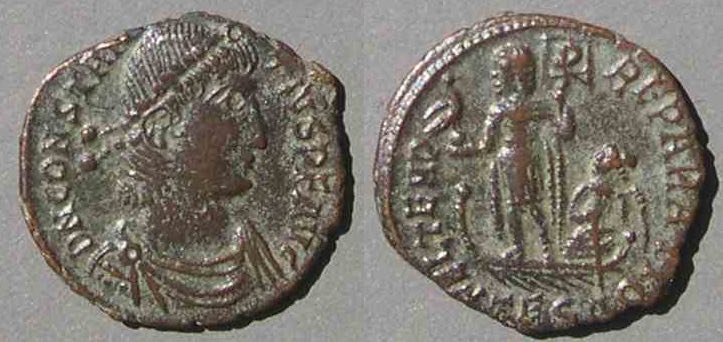
FEL TEMP REPARATIO,
emperor on galley, holds phoenix or Victory
This example: 18 mm. RIC VIII Thessalonica 119.
Possibly a half-denomination.
This is the smaller size of the "galley" type.
Note for collectors: This example may actually be a different denomination, 1/2 the other. On the other hand, it might just be a later, smaller, version. An image above shows that the soldier-spearing-fallen-horseman type declined in size over time, with no obvious line of distinction that suggests the smaller ones are a half denomination. However, these galley types come in two distinct sizes, without the intermediate sizes found for the soldier-spearing-fallen-horseman type.
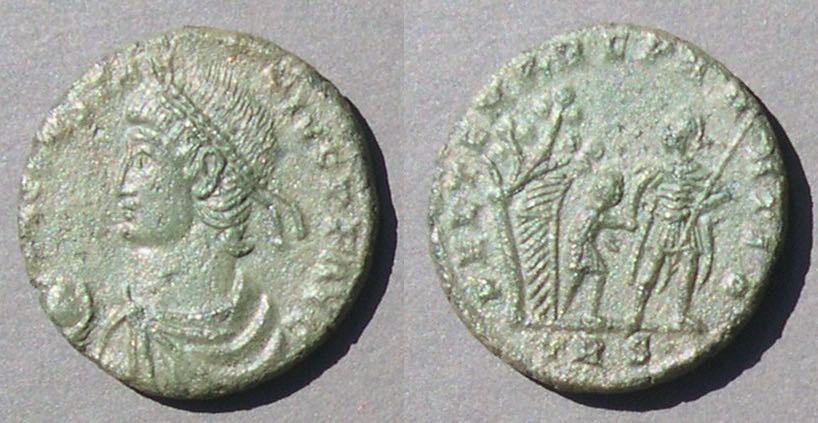 FEL TEMP REPARATIO,
FEL TEMP REPARATIO,F411: FEL TEMP REPARATIO, emperor with two captives
 FEL TEMP REPARATIO
FEL TEMP REPARATIO
emperor with two captives to left
This example: 20 mm. RIC VIII Nicomedia 67
Note for collectors: This type is very common. The two captives can be almost standing, as here, or kneeling. This example has a standard with a chi-rho. Others have a cross or a cross-rho. On some it just looks like an X.
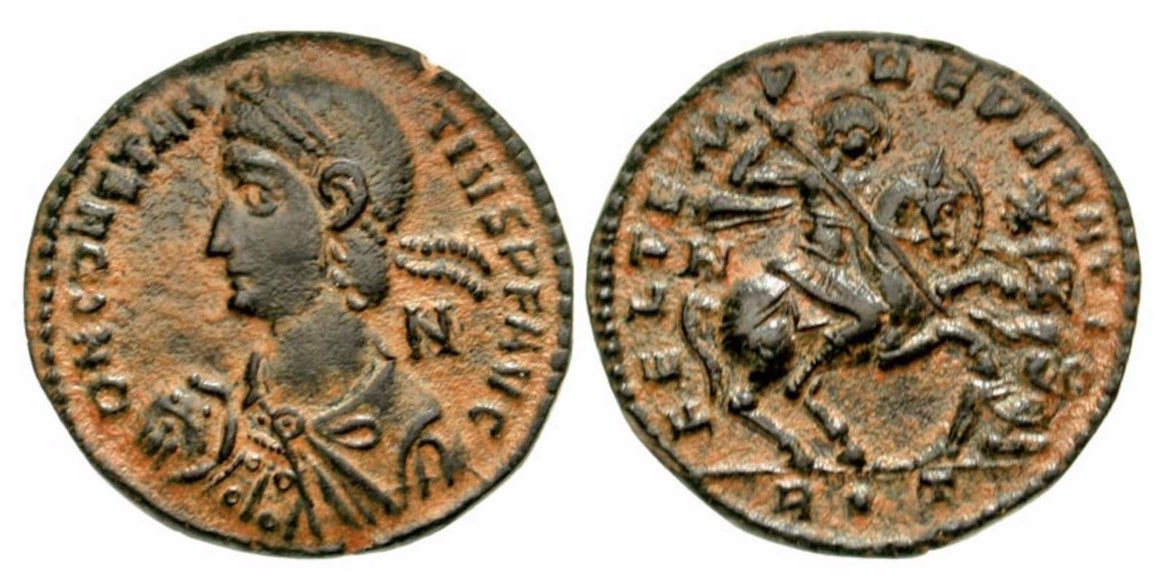
F425: FEL TEMP REPARATIO, emperor and one captive
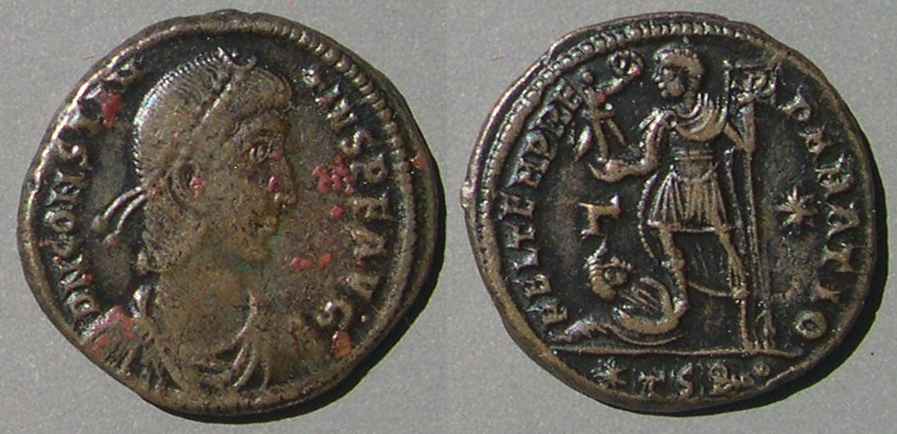
FEL TEMP REPARATIO
emperor and one captive to left.
Only at Thessalonica.
This Example: 24 mm. RIC VIII Thessalonica 178.
Note for collectors: This type is the second-rarest FTR type available. It is rarely in the sort of top condition in which other FEL TEMP REPARATIO types are often found.
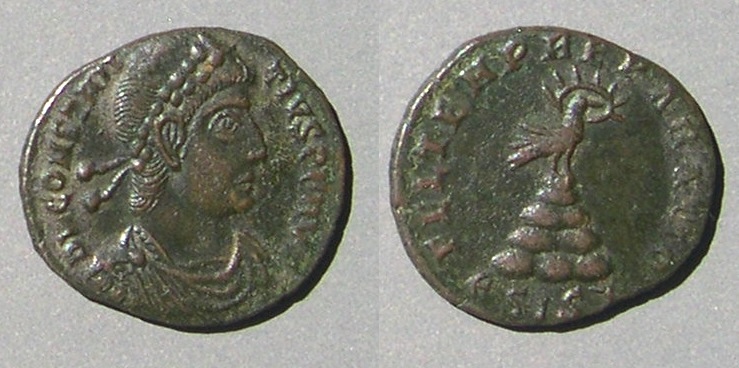
 Issued by Vetranio, 350
Issued by Vetranio, 350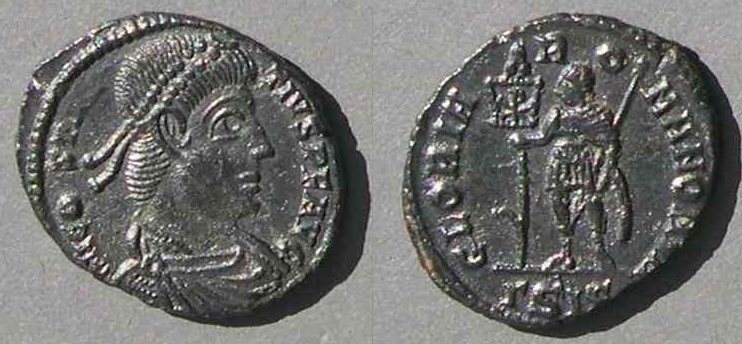 Issued by Vetranio, 350
Issued by Vetranio, 350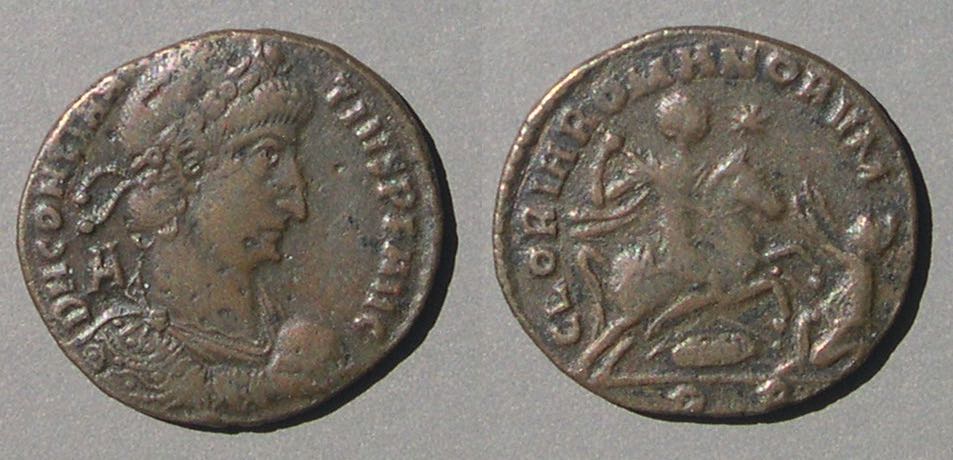
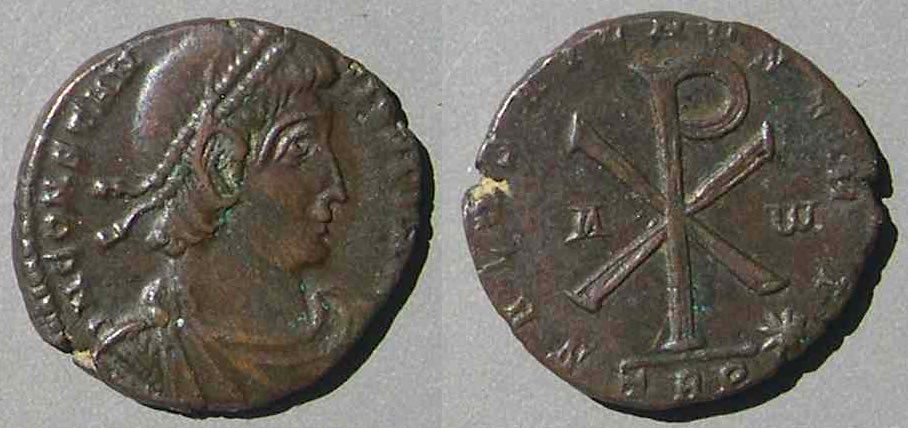
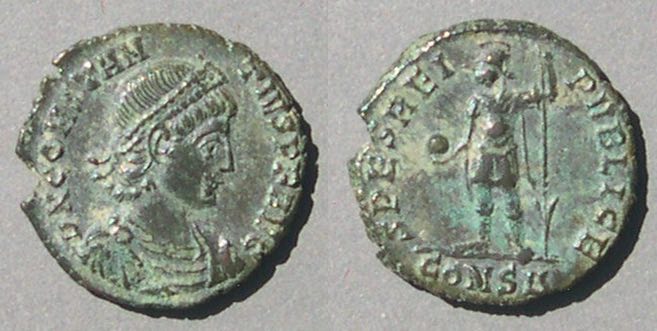
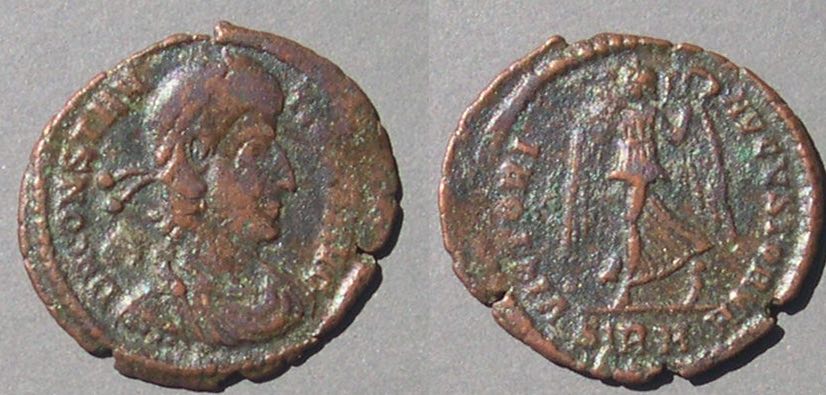
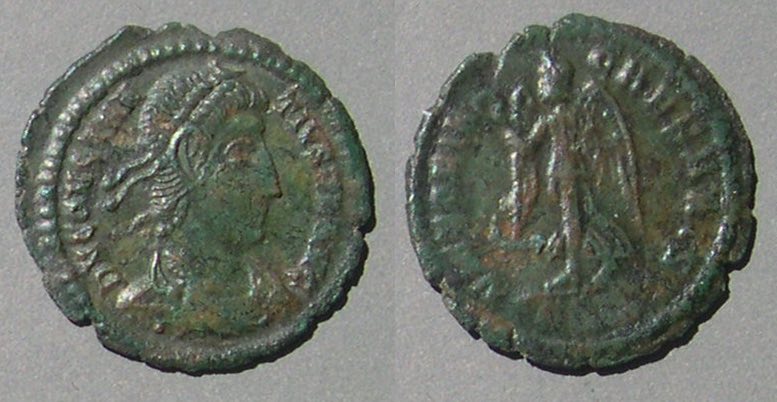
"Types" and "varieties". The line between "type" and "variety" is fine. Is a gampgate with four towers different from an otherwise-similar campgate with three towers? Yes, for some collectors, but, for purposes of this page, it is regarded as a different variety of the same type. Some basic designs have varieties of special interest. For example, the extremely common GLORIA EXERCITVS with two standards very rarely has a Christian chi-rho between the standards. As a collectible, the chi-rho variety is far more valuable. Does that make it a different type? For purposes of this page, chi-rho variety is regarded as a variety, so the answer is "No". What about different sizes of the same design? The common soldier spearing fallen horseman; type comes is sizes from 24 mm down to 17 mm:
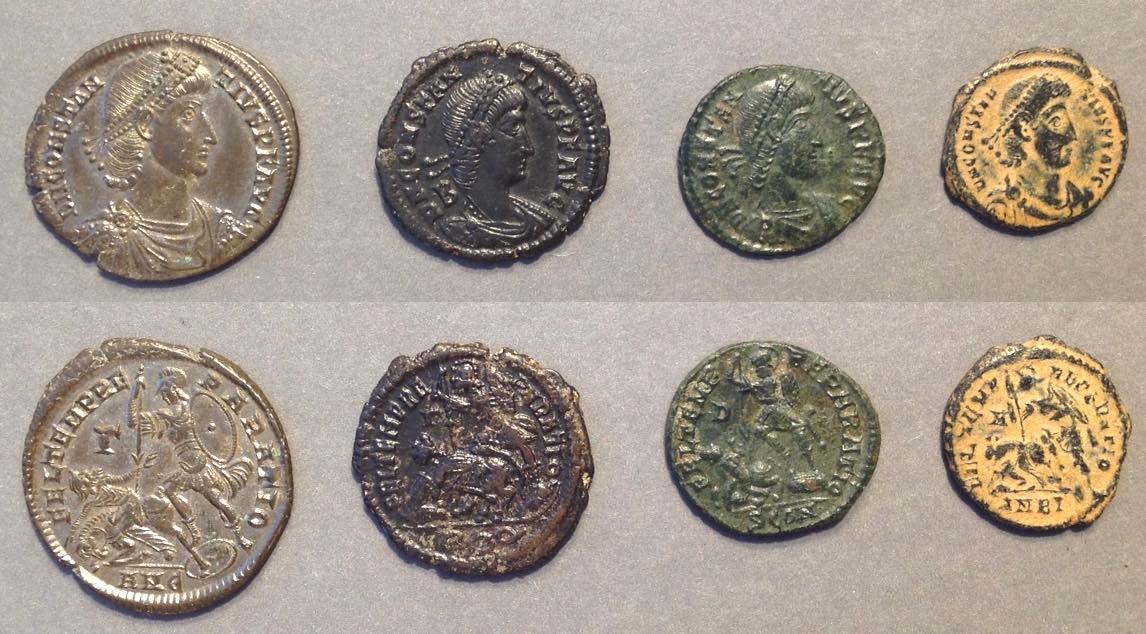
Where should the line between types be drawn? Collectors have good reasons to prefer the larger examples and distinguish mints and special varieties, but this page does not. Academically, and in RIC, mint and field marks allow us to distinguish issues. US coins of the same design from different mints are considered different types. I choose not to draw those distinctions and call all coins with the same central design and legend one "type". This page is about reverse types. Some of the types, especially those as Caesar, come with various bust varieties. Interesting bust varieties may add a large premium to the value, but are not part of this list of reverse types. You are, of course, welcome to distinguish varieties as important to your collection in any way you like.
References.
RIC VII (for coins as Caesar)
RIC VIII (for coins as Augustus)
Failmezger, Victor. Roman Bronze Coins From Paganism to Christianity: 294-364 A.D. 2002. Hardcover, 156 page plus 42 color plates. A very good book with very many color photographs and tables of all sorts of things (e.g. historical events, FEL TEMP REPARATIO varieties) of interest to collectors.
Bruck, Guido. Die Spätrömische Kupferprägung. 1961. Hardcover. xiv plus 101 pages of drawings by type with emphasis on how to distinguish differences including emperors, mints, headdresses, adjuncts, legend breaks, etc. Also has counts by ruler and mint, making is easier to tell which types belong to which rulers. It is in German, but that hardly matters except for the introduction. This book has been largely reproduced on line here:
https://www.tesorillo.com/aes/home.htm (It lacks the counts of how many of each type were in the sample collection.)
For example, which mints have "soldier-spearing-fallen-horseman" in the "sitting" variety? This site will tell you by showing you drawings of the different poses with their mints given: https://www.tesorillo.com/aes/024/024i.htm
Links:
1) This page was page 1. Return to the top of this page.
2) A page with additional images of FEL TEMP REPARATIO types.
3) A page with additional images of types issued for Constantius II by Vetranio
4) A page with additional images of other types.
Go to a similar page about types of Constans.
Go to the main Table of Contents of this whole educational web site.